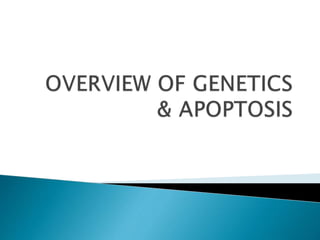
Genetics: DNA, Genes, Heredity & Mendel's Work
- 2. The study of genes and the inheritance of traits Gregor Mendel’s work determined that hereditary characters are transmitted to offspring by separate units Later known to be genes
- 3. These are features you exhibit physically ( your looks) Example: Eye color - green
- 4. The different versions of a characteristic Example: blue, green, and brown eyes
- 5. Occurs when traits are passed down from parent to child.
- 6. Most human cells contain 46 chromosomes: 2 sex chromosomes (X,Y): XY – in males. XX – in females. 22 pairs of chromosomes named autosomes. 6
- 7. 1
- 8. DNA stands for deoxyribose nucleic acid This chemical substance is present in the nucleus of all cells in all living organisms DNA controls all the chemical changes which take place in cells The kind of cell which is formed, (muscle, blood, nerve etc) is controlled by DNA The kind of organism which is produced (buttercup, giraffe, herring, human etc) is controlled by DNA 2
- 9. DNA is a very large molecule made up of a long chain of sub-units The sub-units are called nucleotides Each nucleotide is made up of a sugar called deoxyribose a phosphate group -PO4 and an organic base 3
- 10. Ribose is a sugar, like glucose, but with only five carbon atoms in its molecule Deoxyribose is almost the same but lacks one oxygen atom Both molecules may be represented by the symbol 4
- 11. The most common organic bases are Adenine (A) Thymine (T) Cytosine (C) Guanine (G) 5
- 12. The deoxyribose, the phosphate and one of the bases adenine deoxyribose PO4 Combine to form a nucleotide 6
- 13. A molecule of DNA is formed by millions of nucleotides joined together in a long chain PO4 PO4 PO4 PO4 sugar-phosphate backbone + bases 7
- 14. In fact, the DNA usually consists of a double strand of nucleotides The sugar-phosphate chains are on the outside and the strands are held together by chemical bonds between the bases 8
- 16. Nitrogenous Base (A,T,G or C) “Rungs of ladder” “Legs of ladder” Phosphate & Sugar Backbone
- 17. Bits of information passed down from parent to child. Made of chemicals called DNA.
- 18. How DNA works National Human Genome Research Institute - NIH
- 20. The sequence of bases in a gene is a code instructing the cell how to construct a particular protein – i.e. the number of amino acids and the order in which they are to be assembled. His Met Phe His Glu Pro Cys Cys MAGlu K
- 22. Recombinant DNA technology PCR Botting technique Southern Blotting Western Blotting Northern Blotting
- 24. Synthesis of hormones Laboratory diagnosis Gene therapy Use in forensic medicine
- 25. Trisomy 21 Turners syndrome Klinefelters syndrome X-linked disorders
- 26. Point mutation Frame shift mutation
- 27. Oncogenes (RET proto-oncogene) Tumor suppressor genes ( p53 , RB gene) Telomerase
- 28. Apoptosis is also called as programmed cell death Controlled by cell’s genes Cell suicide Different from necrosis No inflammation Physiological process
- 29. Apoptosis for proper development of tissues Apoptosis for normal functioning of body Apoptosis of cells that are a threat to integrity of tissues
- 30. Internal stimuli External stimuli Final common pathway
- 31. DNA fragmentation Cytoplasm and chromatic condensation Membranous bleb formation Phagocytosis of debris